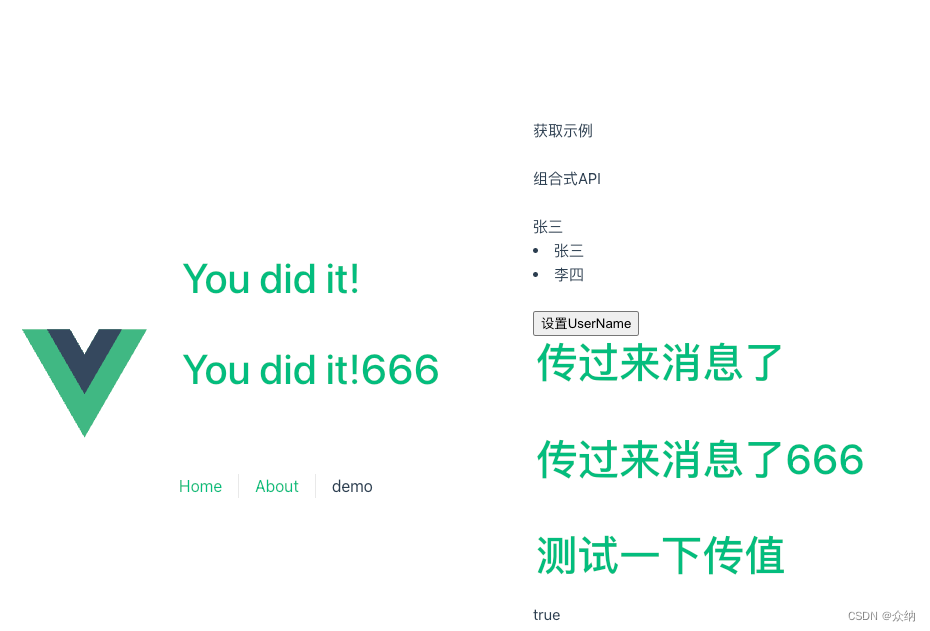VUE3相较VUE2的亮点很多,作为后端开发置于前端最大的感受就是组合式API(之前采用的是选项式API);它使得整体更简洁易用,但值得提醒的是官方并未强制要求二选一,尽管如此在同一个项目中还是不要出现两种写法。
选项式API
优点
优点:
.VUE2 写法;学习成本低
.选项式类似树结构,阅读方便
.能基本满足后端开发的常见需求
示例
<template><div class="about"><p>{{ msg }}</p><br><p>{{ getMsg }}</p><br><p>{{ user.name }}</p><button @click="setMsg()">配置信息</button></div>
</template>
<script>
export default {name: 'About',data() {return {msg: '选项式API',isDelete: false,user: {name: '张三',age: 18}}},methods: {setMsg() {this.msg = '配置新信息'}},computed: {getMsg() {return this.isDelete ? 'false' : 'true'}}
}
</script>组合式API
优点
.基于TS速度更快
.生命周期可以重复使用
.父传子可以直接调用(Provide传 Inject接)
.无须再到对应的事件里写事件,直接写就能直接调用
示例
<template><div><p>获取示例</p><br><p>{{msg}}</p><br><p>{{user.name}}</p><li v-for="item in userList">{{item.name}}</li><br><button @click="setUserName">设置UserName</button><HelloWorld msg="传过来消息了" /><p>{{deleteMsg}}</p><br></div>
</template><script setup>
//直接引用 ref 相当于单个变量的引用
//reactive 相当于对象引用
//ref 与 reactive 相当于 选项式API中的 data
import {ref,reactive} from "vue";
//引用vue的挂载事件 否则无法定义组件事件
import {onMounted} from "vue";
//父传子使用
import {provide} from "vue";
//启用计算属性
import {computed} from "vue";
import HelloWorld from "@/components/HelloWorld.vue";const msg = ref('组合式API')const isDelete = ref(false)const user = reactive({name: '张三',age: 18})const userList = ref([{name: '张三',age: 18},{name: '李四',age: 19}])onMounted(() => {console.log('组件挂载')})//定义组件事件function setUserName() {user.name = '最新设置UserName'msg.value = '最新设置msg'}//传值provide('sendMsg','测试一下传值')//计算属性const deleteMsg = computed(() => {return isDelete.value ? 'false' : 'true'})</script>子组件
<template><div class="greetings"><h1 class="green">{{ msg }}</h1><br><h1 class="green">{{ newMsg }}</h1><br><h1 class="green">{{ getMsg }}</h1></div>
</template><script>
// 使用inject进行接收
import {ref,inject} from "vue";export default {props: {msg: {type: String,default: 'Hello World'}},setup(props,ctx) {//获取props数据const newMsg = ref(props.msg+'666')//可以获取上下文对象console.log(ctx)const getMsg= inject('sendMsg')return {newMsg,getMsg}}
}
</script>效果

)



![[AIGC] @Component与@Bean的区别详解](http://pic.xiahunao.cn/[AIGC] @Component与@Bean的区别详解)














